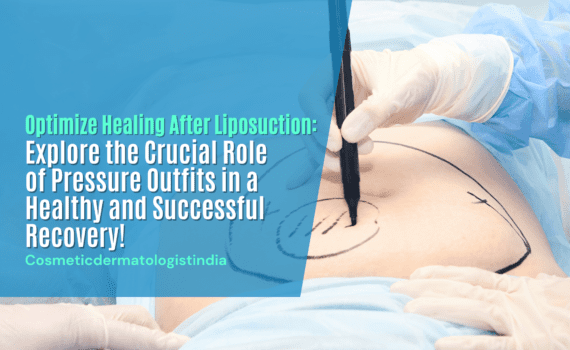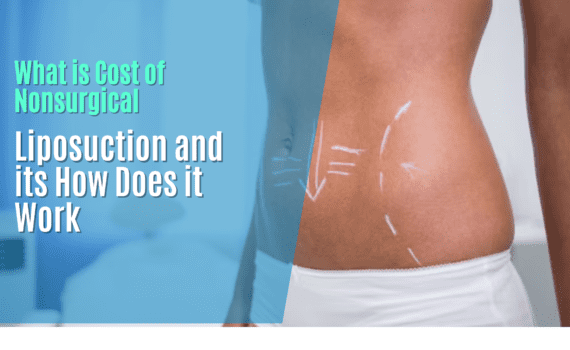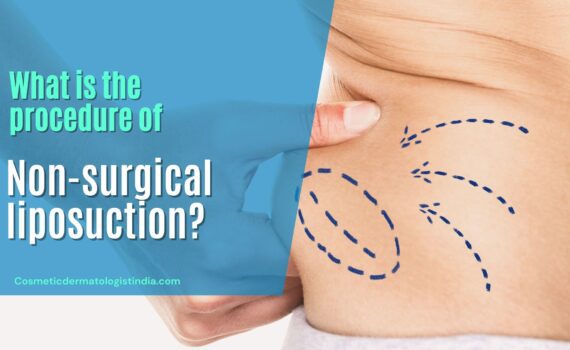
Optimize Healing After Liposuction: Explore the Crucial Role of Pressure Outfits in a Healthy and Successful Recovery!
Millions worldwide are working towards losing weight and getting the perfect contours they admire and often lust after. Sometimes, when exercise and diet don’t work, liposuction can help immensely. With modern options such as laser liposuction in India, liposuction results are much more refined, effective, and long-lasting.
The evolution of intelligent compression garments and pressure outfits has facilitated the speedier healing of laser liposuction in India. The pressure garments apply targeted pressure and support to the treatment region. Today, these garments are an essential element of the post-liposuction care routine and are frequently included in the cost of non-surgical liposuction. The primary objective of compression garments is to shorten the recovery period, reduce discomfort and swelling, and help achieve the best possible results following laser liposuction. Before we go into pressure suits’ benefits, types, and science, let’s look at how liposuction works.
An overview of liposuction surgery and its healing process
Liposuction is a part of the range of body contouring procedures that have gained massive popularity in recent years. However, immaculate post-operative care is as indispensable as going to the best liposuction surgeon for the best possible results and seamless recovery in these surgeries.
During liposuction procedures using lasers, fat deposits in specific areas of the body are targeted with laser energy. The heat and power of the laser break down the fat pockets, flushing them out of the body.
A thin cannula (tube) equipped with a laser fiber is inserted into the fatty tissue through these incisions. The laser energy is delivered directly to the fat cells, causing them to rupture and liquefy. The liquefied fat is gently suctioned out of the body using a suction device attached to the cannula. The laser energy of laser lipolysis also stimulates collagen production, which can help tighten the skin in treated areas. The trauma of laser lipolysis does cause some disruption of tissue and damage to the blood vessels and surrounding areas. Laser lipolysis, a minimally invasive technique, typically causes less trauma than traditional liposuction procedures.
Laser liposuction can contour and remove fat from different parts of the body, such as the abdomen, armpits, chin and neck, love handles, buttocks, arms, back, chest, and knees. The specific treatment areas can be tailored to each patient’s individual needs and aesthetic goals during a consultation with a qualified plastic or cosmetic surgeon.
The key to recovering post-laser liposuction in India is using pressure outfits or compression garments. Before the procedure, one should be committed and fully understand the need for pressure garments to prevent complications and achieve a seamless contour.
Good post-operative care optimizes the results.
Following the laser liposuction procedure in India, some common side effects include swelling, bruising, and inflammation in the treated area. Taking good care of the skin using pressure outfits, a good diet, and hydration helps reduce the side effects, improve fluid drainage, and improve faster healing.
Healing after laser lipolysis in India takes about six months to show full results. During this time, you must wear compression garments regularly at various stages. This helps fill the dead space under the skin and minimizes the potential risk.
What exactly is a pressure outfit, a pressure garment, or a compression garment?
These are specially made body-hugging clothing that is made of specialized elastic. Top surgeons recommend them for post-laser liposuction and other surgeries. They are highly stretchable and exert constant pressure on the treated area.
They are crafted to deliver precise pressure to optimize healing without cutting off the body’s circulation or causing discomfort and pain.
A medical compression garment is usually made of synthetic but breathable fabrics such as nylon or lycra. Some fabrics worn in the last stages of healing are made of cotton materials, too. They come in a variety of sizes and are made with graduated and multidirectional stretch so that the pressure is distributed evenly. Your laser liposuction surgeon will order several sizes so you can adjust the pressure over time. A well-fitted pressure outfit will always feel snug but never tight or painful.
What are the benefits of pressure outfits?
- They help reduce the swelling by preventing fluid accumulation and bringing down the swelling.
- Compression garments improve skin retraction and contouring post-laser liposuction.
- They aid in blood circulation and improve lymphatic drainage.
- They help improve posture, reduce pain, and aid post-treatment care.
- Wearing pressure garments applies gentle pressure to the area, which helps seal the damaged blood vessels and reduces the risk of bleeding and blood collection under the skin.
- Greatly reduce post-process bruising by keeping blood away from the skin’s surface.
- Although laser liposuction in India is a non-surgical option for body contouring, there can still be scarring at the incision site. Wearing compression garments stabilizes tissues and keeps the skin around the incision tension-free.
Thus, with so many benefits, compression garments are a safe and effective way to aid faster recovery and give seamless results in tighter and improved contour by preventing lax or wrinkled skin. You can return to your regular preprocedural routine earlier.
What should be the pressure of pressure outfits?
The pressure of a compression garment used after laser liposuction or any other surgical procedure can vary depending on individual needs and the surgeon’s recommendations. However, compression garments should generally provide enough pressure to support the treated areas, reduce swelling, and promote healing without causing discomfort or restricting blood flow. The standard range is between 20 and 30 mmHg.
Types of pressure outfits
Compression garments are available in various forms and styles, each designed to offer precise levels of compression and support to distinct body parts. Some popular pressure garment forms are used following liposuction, such as laser liposuction.
- Compression Bodysuits: These full-body clothes compress and support numerous areas, such as the abdomen, flanks, thighs, and buttocks. Bodysuits often have adjustable straps and closures for a tailored fit.
- Compression vests are designed to target the chest and back, offering support and compression after treatments such as gynecomastia surgery or upper-body liposuction. They frequently include adjustable hook-and-loop closures for a secure fit.
- Abdominal binders are designed to compress and support the abdomen and lower back. They come in various forms, such as wrap-around binders and adjustable elastic bands.
- Compression shorts are intended to support and compress the buttocks, hips, and thighs after liposuction or fat transfer treatments. They frequently have seamless construction and breathable materials for comfort.
- Compression arm sleeves are designed to provide compression and support to the arms and upper torso following treatments such as arm liposuction or Brachioplasty (arm lift). They come in various sizes and styles, including full-length and elbow-length sleeves.
- Compression leggings target the legs and lower body, offering support and compression after operations like thigh liposuction or lower body lifts. They frequently use graded compression to enhance circulation and minimize swelling.
- Compression socks and stockings support and compress the feet, ankles, and calves after treatments such as vein therapy or foot surgery. They are available in various lengths and compression levels to meet the needs of different customers.
- Compression bras are intended to support and compress the breasts and chest area after surgeries such as breast augmentation or reduction. They frequently include adjustable straps and closures for a tailored fit.
- Compression Chin Straps: These are designed to gently compress the chin and neck area following facial liposuction or neck contouring procedures. By applying consistent pressure to the treated area, chin straps help reduce swelling and promote skin retraction.
- Facial Compression Wraps: Similar to chin straps, facial compression wraps are designed to compress the lower face and neck areas. They typically wrap around the jawline and neck and are adjustable for a comfortable fit. These wraps help reduce post-operative swelling and support the healing process.
These are just a few of the standard pressure suits used following surgical procedures. The type of compression garment recommended will depend on the precise areas treated and the patient’s individual demands. To achieve the best results and recovery, follow the surgeon’s recommendations for the type of compression garment and how long to wear it each day.
What are the common materials used in making pressure outfits?
Different materials used for making pressure outfits are
- Spandex, or lycra, is the most common material as it easily conforms to the body contours.
- Nylon, which is more durable and robust, retains shape for a long time.
- Polyester is known for its moisture-wicking or quick-drying properties, keeping the skin dry and comfortable.
- A cotton lining or blend is preferred for its softness and breathability and can be comfortably worn against the skin.
- Microfibers are the new-age smooth, durable, quick-drying fibers known for comfort and performance.
- Latex is used for additional support and compression but does not suit all skin types.
As the type of material affects the cost of non-surgical liposuction in recovery, you must select the correct type of pressure outfit for recovery.
How to choose the right pressure outfit.
Consult your surgeon for recommendations on the type of outfit that will suit you. The major consideration is the type and area of liposuction performed. Here are some tips on choosing the right compression garment post-laser liposuction in India.
- The garment should be close-fitting for uniform compression.
- The material should be stretchy for ease of movement.
- Good-quality pressure garments are made of breathable materials to prevent skin irritation because of sweating and friction.
- The garment should be seamless to reduce friction and irritation against the skin.
- Last, the garment should be easy to wear with zippers and hook-and-eye closures.
- Tips for wearing pressure outfits
- Wear them consistently, as directed by your liposuction surgeon.
- Keep the outfit clean and dry.
- Use proper care instructions for longevity.
The length of time one should wear a compression garment depends on the scope of the garment and individual healing rates. Initially, they should work 24 hours a day for the first six weeks, and then, as their health improves, they should work 10–12 hours daily for the subsequent three weeks. If the liposuction is extensive, then the duration of wearing will extend.
Remove the compression garments only for bathing and dressings, if necessary. Follow the surgeon’s recommendations for healing, and don’t try to self-heal. If the pressure gets loose or starts to go wrong, change it immediately. Allow the garments to air dry post-washing, and buy an extra pair for good hygiene practice.
The right way to wear compression garments.
- Make sure the garment covers the operating area fully and even a little beyond that.
- Make sure that the fit is snug at all times.
- The pressure garment should not bunch or wrinkle at any part of the body.
- Remove the garment carefully to prevent stretching and spoiling its shape.
- Make Ensure you drink enough water to improve circulation and reduce the risk of blood clots.
- Use mild soap and water to wash the pressure garments.
It is normal for the compression outfit to feel a bit tight in the initial days, but you will slowly get used to it. However, if you are allergic to compression garment materials, then avoid wearing the garments.
Your liposuction surgeon will also give you an alternative to pressure outfits if you are pregnant or have a medical condition like open wounds, impaired circulation, active infections, other skin conditions, or nerve damage.
Conclusion
Compressive garments must be utilized and maintained correctly for laser liposuction to be successful in India. If you don’t wear the right pressure outfit, it can have some potential consequences, such as
- Increased and long-lasting swelling
- Prolonged recovery and delayed healing
- Uneven contouring and the risk of irregularities in the treated area
- Increased likelihood of hematoma and seroma requiring further medical intervention.
It is important to note that adhering to the prescribed regimen and consistently donning compression garments can greatly facilitate recovery, diminish edema, and improve overall outcomes subsequent to liposuction. Nevertheless, it is essential to balance comfort and well-being when utilizing compression garments. Consult the surgeon regarding any concerns or discomfort that may arise from donning compression garments to determine the most effective course of action.
Wearing pressure outfits under professional guidance is essential for the overall well-being and recovery post-laser liposuction in India. Contact Us to know More.








